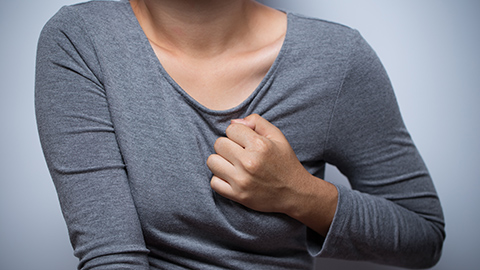11/27/2020

Can a client with extensive scarring from multiple surgeries for breast cancer have improved pain and range of motion with just a few sessions? It seems implausible, but it happens more than you’d think. See this episode’s show notes for additional helpful resources on this topic.
Helpful resources:
- Dynamic angular petrissage on YouTube
- Massage Therapy Without Borders podcast
- Scar Tissue Management CE Course
- Traumatic Scar Tissue Management
Notes:
- Franchelli, S. et al. (2012). “Breast Implant Infections after Surgical Reconstruction in Patients with Breast Cancer: Assessment of Risk Factors and Pathogens over Extended Post-Operative Observation.” Surgical Infections 13, no. 33 (2012): 154–58. https://doi.org/10.1089/sur.2011.004.
- Lewis, P. A., & Cunningham, J. E. (2016). “Dynamic Angular Petrissage as Treatment for Axillary Web Syndrome Occurring after Surgery for Breast Cancer: A Case Report.” International Journal of Therapeutic Massage & Bodywork 9, no. 2 (2016): 28–37. https://doi.org/10.3822/ijtmb.v9i2.297.
- Sinha, I. et al. (2017). “Late Surgical Site Infection in Immediate Implant-Based Breast Reconstruction.” Plastic and Reconstructive Surgery 139, no. 1 (2017): 20–8. https://doi.org/10.1097/PRS.0000000000002839.
- Wilk, I. et al. (2015). “Application of Tensegrity Massage to Relive Complications After Mastectomy—Case Report.” Rehabilitation Nursing: The Official Journal of the Association of Rehabilitation Nurses 40, no. 5 (2015): 294–304. https://doi.org/10.1002/rnj.142.


This podcast sponsored by:
00:00 Speaker 1: Ruth Werner's best-selling book, A Massage Therapist's Guide To Pathology, is a highly regarded comprehensive resource that sets the standard for pathology education. Written for massage therapy students and practitioners, this groundbreaking resource serves up a comprehensive review of the pathophysiology signs, symptoms and treatment of more than 500 diseases and disorders. Learn more at booksofdiscovery.com. Oakworks is a proud supporter of ABMP and the massage therapy profession, and is happy to extend a special offer to ABMP podcast listeners. For a limited time, all ABMP podcast listeners receive 25% off Oakworks items with the code ABMPSUMMIT25. Go to massagetables.com and use the code, ABMPSUMMIT25 at check out to receive 25% off your Oakworks purchase.
[music]
01:02 Speaker 2: Hi, and welcome to I Have A Client Who, pathology conversations with Ruth Werner, the podcast where I will discuss your real life stories about clients with conditions that are perplexing or confusing. I'm Ruth Werner, author of A Massage Therapist's Guide To Pathology, and I have spent decades studying, writing about and teaching about where massage therapy intersects with diseases and conditions that might limit our client's health. We almost always have something good to offer even with our most challenged clients, but we need to figure out a way to do that safely, effectively and within our scope of practice, and sometimes, as we have all learned, that is harder than it looks. Today's I Have A Client Who's story comes to us from a massage therapist in Florida who shares this, "I had a client who had had breast cancer, she had a mastectomy followed by a breast reconstruction, but then she had a post-surgical infection, so the reconstruction was removed. A second attempt also failed due to infection. She complained of decreased range of motion inflection at the right shoulder, and her treatment included gentle work all around the shoulder girdle, this improved her comfort, but her range of motion was still limited."
02:35 S2: "I asked to see her scar and... Wow, I have never seen a scar like that. I changed my work to address her scar tissue, one session restored partial range of motion, a second session gave her full range of motion. We did one more session, the client was amazed." This is such a beautiful story with a happy outcome, especially since it could have gone a different way. Now, the story could take us in a few different directions, and I'll choose a couple, but first I wanna take a moment, as I always do, to thank this contributor for sending us this really fascinating case to talk about, and I wanna invite you to send me your I Have A Client Who stories. You can send them to me at ihaveaclientwho@abmp.com, that's ihaveaclientwho, all one word, all lowercase, @abmp.com. So I wanna talk about a couple of things related to the story. First, we'll look at post-surgical infection risk for breast reconstructions, and then I would love to talk a bit about post-surgical scar tissue, which will give me a chance to bring your attention to a really cool research project, and also to some terrific resources about massage and scar tissue in general.
04:03 S2: So in regards to post-surgical infections, I was surprised at how easy it was to gather some information on this issue, which I thought would be relatively rare, but it turns out it's not. One study from Italy in 2012 looked at the infection rate for post-mastectomy reconstruction surgeries, and it was, at least to my mind, relatively high at 6.7%. This covered a range of about 1.5% up to 12%, depending on which populations were being studied. Some of the factors linked to a higher risk for infection include the use of chemo, radiation, axillary node dissection among others. It also turns out that breast implants after a mastectomy carry some fairly significant risks for complication on their own, including local contractures, skin necrosis, hematoma, and of course, infection. So this study by Franchelli et al, is linked in our show notes for today. Another study out of Boston from 2018 by Sinha, found that post-surgical infection rates ranged from about 2.5% to 9.5% depending on the type and timing of the procedure, but most of those infections occurred more than 30 days after the first surgery and that means patients need to build into their treatment and aftercare, special vigilance about infection that might occur many weeks after their procedures. This could be a heads-up for massage therapist too, if we are working with clients throughout their cancer treatment and treatment recovery periods.
05:42 S2: Now, this massage therapist reports that her work with her client's scar tissue led to improved range of motion over a very short period, and I have a couple of reasons to be really skeptical about this. For one thing, it's pretty unusual to see big, lasting changes occur with only short interventions, so it seems a bit of a stretch, see what I did there, that's a bit of a stretch that this client's range of motion was improved with only two or three massage sessions. Also, we know that tissues involved in building scars, including surgical scars, is incredibly dense and tough, and it's not gonna be broken down with any kind of manual therapy, and yet, this is not at all the only time I've heard stories like this where a post-surgical scar tissue appears to respond in a very positive way to careful skilled massage. One of my favorite case reports ever that I use a lot when I'm teaching about research is called Dynamic Angular Petrissage as a treatment for axillary web syndrome occurring after surgery for breast cancer, and is by a registered massage therapist from Ontario named Paul Lewis. And of course, it will be linked in our show notes. Now, axillary web syndrome is a fairly common post-surgical complication for people who've had memes, and it involves the growth of thick, painful constraining bands of connective tissue from the exile down the arm.
07:18 S2: Some patients even have it going past the elbow all the way down to the wrist. This isn't the same as the situation with our client in today's description, but there are some commonalities. Here's a client who's recently been through treatment for breast cancer, she developed painful restricting scar tissue, and in this case, her massage therapist used this particular kind of treatment he calls Dynamic Angular Petrissage, and after two treatments that she reported being painless, she had no range of motion restrictions in her shoulder at all, and at a follow-up three months later, she had no visual or palpable evidence of scarring, and she still had unrestricted range of motion at her shoulder and no pain. If you're interested in Dynamic Angular Petrissage, I will include a link to a YouTube video where Paul Lewis demonstrates this technique. I have another case report out of Poland looking at something called 10 secret massage for a woman with post-surgical scarring from mastectomy. And they had similar results. So although the idea that manual therapy breaks up or breaks down scar tissue is highly suspect, clearly something is happening and it looks powerful. So I have a couple of go-to people about scar tissue and massage therapy. One of them is a massage therapist also from Canada named Cathy Ryan.
08:46 S2: By the way, she and Cal Cates do an amazing podcast called Massage Therapy without Borders, and if you haven't tuned in yet, you are in for a treat. Cathy does continuing education in scar tissue rehabilitation, and she and her colleague, another wonderful expert named Nancy Keeney Smith, have written a book called Traumatic Scar Tissue Management. If you work with clients in this situation, this is an important resource and guess where you'll find a link. Cathy and Nancy also have a two-part continuing education course called Scar Tissue Management that is available free to ABMP members and for a small price to others, and this is also linked in our show notes. So what we have learned through Kathy and Nancy's work and through a fair amount of research is that manual therapy probably does not in fact alter the fibrous construction of mature scar tissue. Rather, it probably alters the quality of that tissue, we see this in. Today's I Have A Client Who anecdote, and in our case reports and in a number of other research pieces that the impact of manual therapy appears to be consistently helpful for people who wanna improve their range of motion and decrease pain with scar tissue.
10:05 S2: Interestingly, this can apply to both brand new scar tissue and that which has been present for a prolonged period of time, so what we see is that manipulation may help scar tissue to become more pliable, stretchier, less restrictive, but it's probably not accurate to suggest that cross-fiber friction or with fiber fiction or Dynamic Angular Petrissage or any other kind of intervention is likely to actually break through well established and mature growths of collagen. So let's return to today's massage therapist and her client, the woman with post-surgical infection and scarring. Boy, this client has been through it, hasn't she? Diagnosed with breast cancer, mastectomy, reconstructive surgery, infection, reconstruction, reversal, another surgery, another infection, another reversal.
11:02 S2: No wonder she has pain and limitation and extensive scarring. And let's remember that inflammation promotes the production of even more scar tissue, so her repeated episodes and multiple surgeries have all conspired to make a particularly challenging situation. It is all inspiring to me, but ultimately, totally believable that she would have a great experience with a skilled massage therapist, and it makes me wonder how many other people out there are living with pain and restriction related to post-surgical infections and scarring. Are you interested to work with these folks. It all begins with advanced education, 'cause these clients are waiting and hoping to find you, and that makes me really proud and happy to be part of this profession.
11:53 S2: Hey everybody, thanks for listening to I Have A Client Who pathology conversations with Ruth Werner. Remember, you can send me your I Have A Client Who stories to ihaveaclientwho@abmp.com, that I Have A Client Who all one word, all lowercase, @abmp.com. I can't wait to see what you send me and I'll see you next time.
12:22 S1: Anatomy Trains is excited to announce a new on-demand video course with Tom Myers coming soon. Deeper ground, restoration and vitality for the female pelvis, reach your deeper ground of embodied awareness and strategic confidence with this four-hour tour of the female pelvis, including its key points and unique challenges. Course highlights include hands-on palpation certainty and technique review for the major muscle groups, assessments and techniques for posterior and anterior pelvic floor. So as complex and diaphragm, common perinatal bio-mechanical issues explained, and much more. Sign up for The Anatomy Trains newsletter at AnatomyTrains.com to be notified when the course is available.





